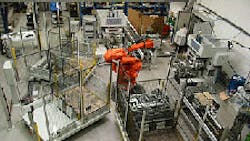Robot production picks up pace in China
An estimated 200,000 industrial robots were produced worldwide in 2012, with the majority of manufacturing taking place in Europe and Japan where a base of established industrial robot producers already exists. However, look for China to become a major player over the next 10 years. Between 2011 and 2016, the production of industrial robots in the Asia Pacific region (excluding Japan) is forecast to grow at a CAGR (compound average growth rate) of 9.6%, more than any other region in the world, with China set to contribute significantly to this growth. The World Market for Industrial Robots, a new report from IMS Research, Austin, explores this trend and many others.
The decision to purchase a robot from one vendor versus another depends on many factors, such as cost, application, location, and range of expertise. In certain circumstances, political alignment may also play a role, say analysts. For example, Chinese end-users may be reluctant to do business with Japanese vendors due to a dispute between their governments over the Senkaku/Diaoyu Islands, and a significant amount of investment into manufacturing infrastructure relies on Chinese Government funding.
Chinese industrial production has increased at a CAGR of approximately 14.5% over the past decade, and the country’s demand for automation has followed suit. In its recently announced five-year plan, it was clear that the country will seek to source goods from domestic suppliers rather than heavily rely on foreign imports. Local manufacturers such as GSK and SIASUN are two examples of domestic suppliers. However, it may take some time for domestic producers to establish credibility, even with low cost solutions, especially because major robot manufacturers such as ABB, KUKA, and Yaskawa have opened up manufacturing facilities in the region.
Arguably the biggest news concerning the industrial robot market in China has been the announcement of Foxconn’s intention to deploy one million robots in its factories during the next two to three years. This news has generally been met with skepticism. That said, there is an undisputed need for the company to invest in automation amid growing concerns regarding the treatment and working conditions of its employees.
Whether or not Foxconn is able to meet its ambitious target, there is little doubt that the interest in industrial robots is growing in China. As the social demographic changes in China, businesses are finding it increasingly difficult to find low-wage laborers as many young people are furthering their education rather than taking vocational apprenticeships. As more local robot manufacturers appear in China, alongside some of the established names, it is clear that industrial robot production is set to increase more than in any other country over the next decade.
The World Market for Industrial Robots includes six chapters with 145 tables covering the EMEA, Americas, Asia Pacific, and Japan regions. The report contains analysis by robot type for eight industry sectors and seven applications with additional breakouts presented by payload, number of axes, and reach. Also included are details on trends, revenue, unit shipment, and analysis of six robot types, as well as market share information for the leading robot suppliers in each region.
For more information, visit IMS Research.
